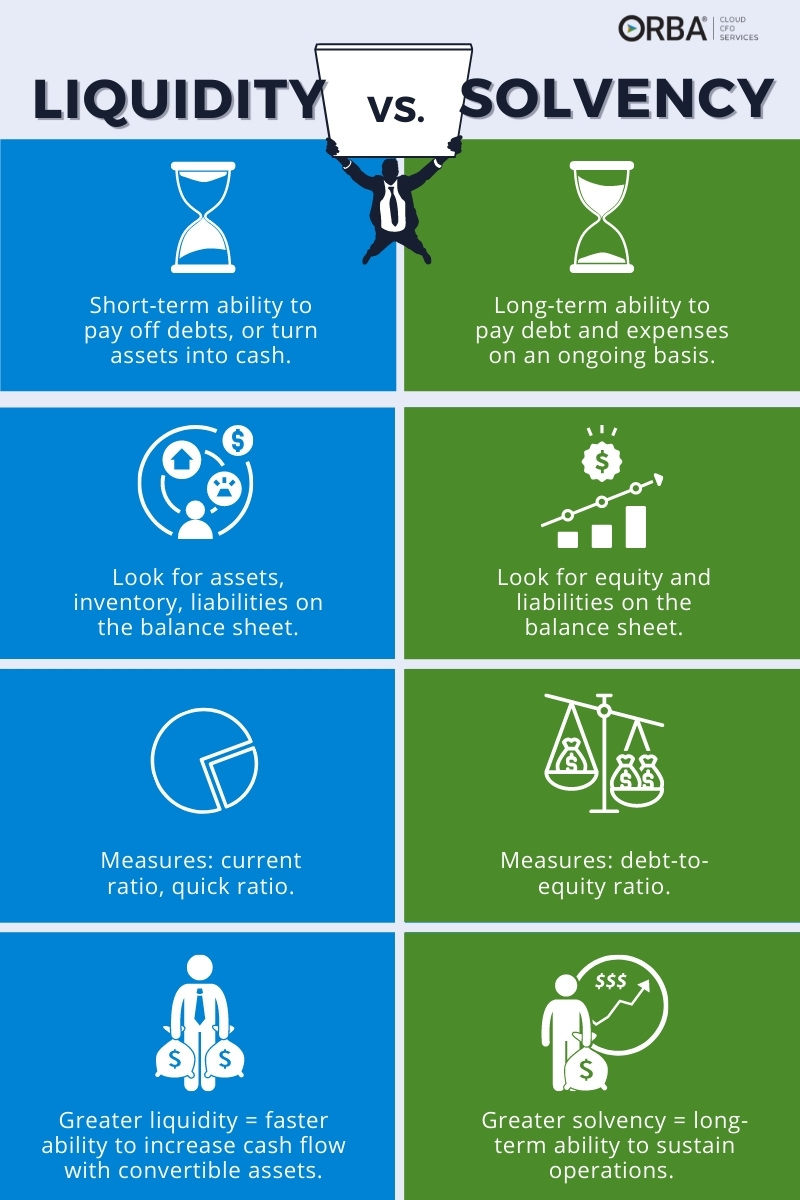Need to know how to find your debt to equity ratio?
Strengthening your balance sheet is crucial, especially during times of economic uncertainty. A key indicator to monitor is your debt to equity ratio—a lower ratio generally reflects a healthier financial position, which is especially vital during economic downturns.
Investors prioritize both liquidity (the health of your assets) and solvency (the health of your debt), and as a business owner, you should too. This means keeping a close eye on financial metrics such as the current ratio, quick ratio, and debt-to-equity ratio. Simply put, debt represents what you owe, while equity reflects what you own. To easily calculate your debt-to-equity ratio and gain invaluable insights into your financial standing, you can use this convenient debt to equity ratio calculator..
What is liquidity?
Liquidity is the short-term ability to cover your debts. Put another way, how quickly you can turn your assets into cash. Liquidity is closely linked to your cash flow. A greater liquidity in cash and convertible assets indicates a financially healthy business. Liquidity is measured using your current ratio (or working capital ratio) and your quick ratio.
Related Read: Applying for a business line of credit? Learn how a business line credit can affect your liquidity ratios.
Current Ratio Formula
The current ratio, also referred to as the working capital ratio, measures if you have enough assets to cover short-term expenses like your accounts payable and payroll. The formula to find your current ratio is: current assets/current liabilities.
Quick Ratio Formula
Your quick ratio, also known as the acid-test ratio, excludes inventory (because some inventory cannot be quickly converted to cash). The formula to find your quick ratio is: (assets-inventory)/liabilities.
What is solvency and how do you track it?
Solvency, on the other hand, is the ability to pay debt and long-term expenses on an ongoing basis. In other words, do your assets cover your debts? Having more equity than debt with a downward ratio trend is a good thing. You want your shareholders financing the operations more than your creditors. That said, increasing your debt to take advantage of an awesome new opportunity can be worth it if properly vetted first, but don’t rely on debt for normal operating expenses. Use our debt to equity ratio calculator below to determine your solvency now.
Debt to Equity Ratio Formula
You can find your total liabilities and your total equity on the ever-important balance sheet.
The formula to find your debt-to-equity ratio is: total liabilities/total equity.
- Your total liabilities include your total short-term and long-term debt plus other liabilities like deferred tax.
- Also found on your balance sheet, your total equity is calculated by subtracting your total liabilities from your total assets, equity = assets – liabilities.
The debt-to-equity ratio is a good measure of both a company’s financial stability and its ability to raise capital to scale. A lower ratio is normally what you are aiming for. Generally, you want your shareholders financing the operations more than your creditors.
Use the debt to equity ratio calculator below to find yours now:
Debt to equity ratio calculator
Typically, you would aim for a debt-to-equity ratio of 2.0 or less. But, in an asset-heavy business, you’re going to have more debt, with large manufacturing or consumer products companies carrying ratios of up to 5.0. So, it’s about finding the right balance of debt-to-equity for your industry and business model. Something our ecommerce accounting services can help with.
One of the best ways to lower the debt to equity ratio is to pay off debt. Ideally this happens with an increase in revenue, but it may be possible to sell assets such as capital equipment or real estate in order to pay down your debt.
Is all debt bad?
Great question. No, absolutely not! All debt is not bad. While you certainly want to show investors and other stakeholders that you are in a good cash flow position, if you are reinvesting in order to grow, that is a perfectly acceptable reason to be short-term in the red.
Cloud CFO Tip: If your controller only pinches the bottom line you’ve got a problem. Say you’ve got a strong balance sheet and are planning to reinvest. If they can’t support an investment in growth, your controller is holding your business back.
Generally, a lower debt-to-equity ratio is better; however, if you have no debt and your ratio is zero, then you should consider what opportunities you might be missing out on. If you can grow more quickly by taking on debt, then it makes sense to do so.
How to use debt to your advantage
Debt used in a responsible way can be very beneficial to accelerate growth. In fact, in many instances, compared to equity, debt can be cheaper by providing tax savings to a company, e.g., interest rates on business loans which are deductible on your company’s tax returns.
Need help with your tax returns? Learn more about ORBA’s tax services.
A few strategic ways to use debt include:
- purchasing another business to help you grow faster.
- funding marketing campaigns to acquire new customers or to build out a customer success program.
- buying equipment that helps you streamline operations.
In these instances, your debt-to-equity ratio may be greater than the ideal 2.0, and that’s okay. A higher debt-to-equity ratio indicates high growth in these examples.
Good CFOs will get creative with how to put your debt to work. Ditch your line of credit and build a rainy day fund, for example. Capitalize on the unique opportunities to secure loans with low-interest rates. If you have a solid P&L and balance sheet without too much existing debt, take out a fixed-term loan to get some cash up front. It can either help you survive in a crunch or better yet, help you double-down.
Is your business ready to double-down? As the Entrepreneur’s CFO, our fractional CFO services can help. Book your free consultation today to learn how.



